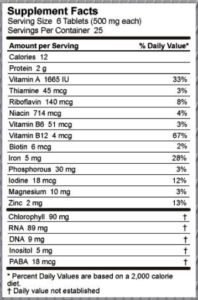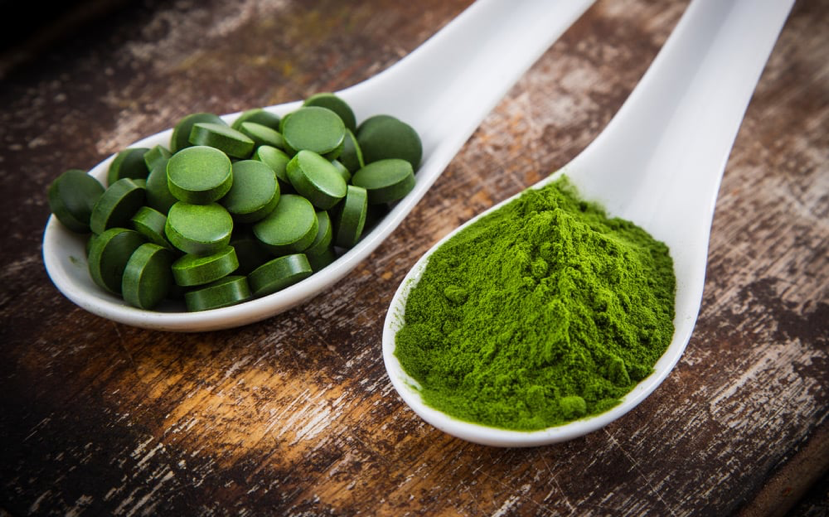Did you know that Chlorella has survived shifts in tectonic plates, ice ages and tropical lulls? If that isn’t enough to make this protein-packed superfood drop jaws, its numerous health benefits allow it to speak for itself.
What is Chlorella?
You may have seen it get a mention in your favourite health magazine, or floating around on the shelves of the supplement shop. You may even know that it’s green, comes from fresh water and is classified as a superfood. What is it about this plant that makes it so “super” though?
There are many interesting things to be said about Chlorella, so let’s keep it simple and start off by looking at what’s in its name. “Chloros” is derived from the Greek meaning of “green”, and “ella” comes from the Latin suffix meaning “small”. These obvious physical characteristics aside, Chlorella is a type of single-cell algae that is found growing in fresh water.
Chlorella can be found in liquid, tablet and powder form and is available at a variety of natural food or supplement stores. It contains the perfect balance of all 9 essential amino acids and a variety of nutrients; some of which being beta-carotene, iron and the B-complex vitamins. Chlorella can often be confused with Chlorophyll, which is the popular health-promoting substance that plants use to make their own food in the process of photosynthesis. It does, however, contain the highest amount of Chlorophyll when compared to any other plant source.
Benefits
The most popularly researched benefits of Chlorella conclude that it:
- Boosts immunity
- Contains a perfect balance of all 9 essential amino acids, making it a complete protein
- Fights infections
- Increases good bacteria in the gastro-intestinal tract
- Relieves constipation
- Can be used to prevent and treat cancer
- Increases white blood cell count
- Plays a role in hormone balancing
- Is antioxidant, which means it destroys dangerous free radicals in the body
- Acts as an anti-tumor
- Can be used on the skin for rashes following radiation treatment and skin ulcers
Chlorella has been used to treat a variety of health ailments dating back to early Asian history, especially serious illnesses such as cancer and fibromyalgia. It is used as a natural treatment for chronic conditions such as:
- Ulcerative Colitis and Chohn’s disease
- Diverticulosis
- Fibromyalgia
- High blood pressure
- High cholesterol
- Cancer patients undergoing radiation
Sinking Deeper into the Nutrition
Chlorella is a micro-alga that is composed of single-cell organisms. This makes it easy for it to bond with small chemical components in the body and neutralize the damage caused by free radicals. For this bonding and proper absorption to occur, it’s important that the cell wall has been broken down prior to consumption (read the label on the supplement you are purchasing it to see if this is stated).
If you were left stranded on an island with only one food, Chlorella would be an optimal choice due to its balanced and nutrient-dense composition. Herbalists recommend that one should consume about 2-3 teaspoons per day, which accumulates to approximately a 10-15g serving. The composition of a 3g serving, which is slightly less than a teaspoon, is as follows:
 (Source: NutriBiotic, 2017)
(Source: NutriBiotic, 2017)
Although fat and carbohydrate content isn’t accounted for on this label, the macronutrient ratio is usually about 60.5% protein, 20.1% carbohydrates and 11% fat (Pitchford, n.d.). This means that in only 3 teaspoons, you would get approximately 12 grams of complete plant-based protein, 4 grams of carbohydrates and 1 gram of fat! Not to mention more than the recommended daily value of iron, vitamin A and b12.
Side Effects and Interactions
With all good things come a few downsides to be mindful of. Although Chlorella is generally safe for consumption, there is the possibility of a sudden allergic reaction after taking the supplement. Common reactions are asthma-like symptoms (chest tightness, difficulty breathing, coughing), hives or itchy and swollen skin. It’s also possible for new users to suffer from gas, nausea, green stools, diarrhea and stomach cramps within the first week of consumption. Those who are sensitive to Iodine and mold are advised to be cautious when consuming Chlorella for the first time.
As always, it’s crucial to take a look at your current prescriptions before beginning a new supplement. Chlorella is usually very rich in vitamin K, meaning that it can reduce the effectiveness of any anti-coagulant (blood thinning) medications. If you’re consuming Warfarin, it’s especially crucial to stay away from Chlorella as they are contraindicative of each other. Due to the fact that Chlorella activates the immune system to a fairly high degree, it’s also important to avoid it if you are suffering from an auto-immune condition such as Multiple Sclerosis, Lupus, Rheumatoid Arthritis, etc. When consuming immuno-suppressants for conditions such as these, Chlorella can work against the medication and speed up what is an already accelerated immune system.
References
RFI Media Ltd. (2017). Chlorella Benefits. Herb Wisdom. Retrieved February 7th, 2017 from http://www.herbwisdom.com/herb-chlorella.html
Web M.D. (2009). Chlorella. Web M.D. Retrieved February 7th, 2017 from http://www.webmd.com/vitamins-supplements/ingredientmono-907-chlorella.aspx?activeingredientid=907&activeingredientname=chlorella
Love Thyself (2016). How Does Chlorella Work in the Body? Love Thyself. Retrieved February 7th, 2017, from https://lovethyself.com.au/detox/chlorella-work-body/
McNight, Clay (n.d.). Chlorella vs. Chlorophyll. SF Gate. Retrieved February 8th, 2017 from http://healthyeating.sfgate.com/chlorella-vs-chlorophyll-10702.html
Rosenbaum, Michael (2015). What is Chlorella Good for? Look to its History! Natural News. Retrieved February 8th, 2017, from http://blogs.naturalnews.com/chlorella-good-look-history/
The Bread Beckers (2017). CGF Chlorella 500 mg 150 Tabs, NutriBiotic. Retreived February 9th, 2017 from http://www.breadbeckers.com/store/pc/NutriBiotic-CGF-Chlorella-500-mg-150-tabs-p3025.htm
Pitchford, Paul (n.d.). Chlorella: A Nutrient-Rich Algae. NaturoDoc. Retrieved February 9th, 2017, from http://www.naturodoc.com/chlorella.htm

